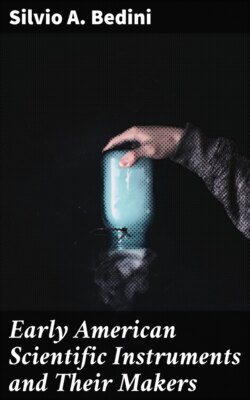Читать книгу Early American Scientific Instruments and Their Makers - Silvio A. Bedini - Страница 9
На сайте Литреса книга снята с продажи.
Colonial Training in Instrument Making
ОглавлениеTable of Contents
One may well ask, where did these native craftsmen acquire the knowledge that enabled them to produce so skillfully the accurate and often delicate mathematical instruments? There were a number of possible sources for this knowledge. The first source lies in England, where some of these craftsmen could have studied or served apprenticeships. After completing their apprenticeship with English mathematical practitioners, they may have immigrated to the Colonies and taught the craft to others. This seems to be entirely plausible, and was probably true, for example, of Thomas Harland the clockmaker, Anthony Lamb, and perhaps several others. However, these were the exceptions instead of the rule, since a biographical study of the instrument makers in general reveals that they were for the most part native to America. It is not likely that the one or two isolated practitioners that had been trained in England could have taught so many others who worked in the same epoch.
Figure 2.—Title page of The Surveyor by Aaron Rathborne, published in London in 1616. The book was one of the sources of information for American makers of mathematical instruments.
Another source for this knowledge of instrument making was probably the reference works on the subject that had been published in England and in France. As an example, Nicolas Bion's Traitè de la Construction et des Principaux Usages des Instruments de Mathematique, which had been first published in 1686, was translated into English by Edmund Stone in 1723, and went into several English editions. Copies of this work in English undoubtedly found their way to America soon after publication. Other popular works were Aaron Rathbone's The Surveyor, which appeared in London in 1616 (see fig. 2); William Leybourn's The Compleat Surveyor, in 1653; and George Atwell's Faithfull Surveyour, in 1662. Other works popular in the Colonies were R. Norwood's Epitome, or The Doctrine of Triangles (London, 1659) and J. Love's Geodasia, or the Art of Surveying (London, 1688).
These works undoubtedly inspired similar publications in America, for many books on surveying and navigation appeared there before the beginning of the 19th century. Chief among them were S. Moore's An Accurate System of Surveying (Litchfield, Conn., 1796), Z. Jess's A Compendious System of Practical Surveying (Wilmington, 1799), Abel Flint's Surveying (Hartford, 1804), and J. Day's Principles of Navigation and Surveying (New Haven, 1817).
The published works were unquestionably responsible for much of the training in the making of mathematical instruments in America, although no documentary evidence has yet been recovered to prove it.
Another important influence on early American instrument-making which must be noted was that of the clockmaker as an artisan. A comprehensive study of surviving instruments and related records has revealed that only a few of the many clockmakers working in the American Colonies in the 18th century made mathematical instruments. Yet, a large proportion of the surviving surveying and nautical instruments produced before 1800 were the work of clockmakers. Classic among these must be noted the instruments produced by the brothers David and Benjamin Rittenhouse (see p. 15 and figs. 3 and 4), as well as the fine surveying instruments made by four separate members of the Chandlee family, whose clockmaking traditions began early in the 17th century (see p. 54).
Figure 3.—Transit telescope made by David Rittenhouse and used by him for the observation of the transit of Venus in 1769. Brass, 33–½-in. tube on a 25-in. axis, with an aperture of 1–¾ in. and a focal length of 32 in. Photo courtesy the American Philosophical Society.
Figure 4.—Surveying compass marked "Potts and Rittenhouse." Believed to be the work of David Rittenhouse in partnership with Thomas Potts. Photo courtesy the American Philosophical Society.
Finally, one must not overlook the fact that examples of English and other European instruments were available in the Colonies, and that at least some of the early colonial makers undoubtedly copied them. It is apparent from some surviving early American instruments that the materials, designs, dimensions, and details of European prototypes had been deliberately copied. It is possible to see in public collections, for instance, a Davis quadrant of English manufacture exhibited beside a later example, signed by a New England maker, which comes extraordinarily close to duplicating it in every feature.
As with the presumed influence of published works, the practice of copying imported instruments cannot be documented, but it must have been engaged in by many of the unschooled New England instrument makers. By this means some may even have profited to the degree that they became professional craftsmen without benefit of formal apprenticeship.
Yet it is remarkable that although numerous instruments were produced by native artisans, in addition to the substantial number which were imported before the end of the 18th century, relatively few specimens have survived in public collections as well as in private hands. Despite the exhaustive combing of attics and barns throughout the country by dealers in antiques and by avid collectors during the past several decades, the number of surviving instruments now known is incredibly small in comparison with the numbers known to have been made locally or imported before the beginning of the 19th century. Since instruments are not items which would ordinarily be deliberately discarded or destroyed, or melted down for the recovery of the metal, this small percentage of survival presents a puzzle which has not been resolved.
Figure 5.—David Rittenhouse. Engraving from portrait by Charles Wilson Peale.
